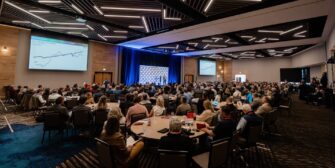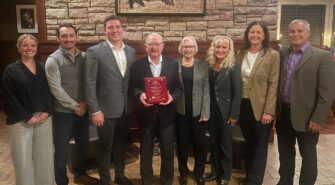3 Family Businesses Honored with Awards from Prairie Family Business Association
Recent News
New ownership takes over at Sioux Corp.
For almost two decades while driving to the airport before returning home to California or Nevada after Christmas, Jack Finger would broach a tough topic: working at his family’s business, Sioux Corp. in Beresford.
It never worked out.
“After receiving a mechanical engineering degree in 1974 from SDSU, my mom wanted me to work at Sioux, but my dad felt like I would do better working for a large corporation, and he didn’t know how it would turn out if I came back to this little company.”
After 17 years of difficult conversations, Jack told them he had given up trying.
“As far as I’m concerned, I never want to talk about it again,” he told them. He obtained a second degree in electrical engineering and became a registered professional engineer in Nevada, not planning to return to South Dakota.
“After four more years went by, they called me and said they decided to retire. And after evaluating all the options, they thought that me coming back would be the best one. They asked if I’d be interested. I said yes.”
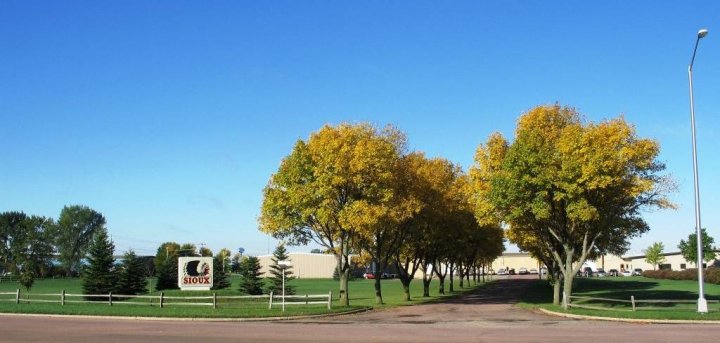
More than two decades later, the “little company” has grown into a solid player in several industries, designing and manufacturing premium, industrial-quality cleaning equipment, water heating and chilling systems, and steam generators from its headquarters in Beresford.
It’s now time for Finger to pass the proverbial torch. He, his mother and a brother and sister recently decided to sell the business to three employees, but only after completing a journey that could serve as a blueprint for other family businesses.
“Sioux Corp. is such a South Dakota success story and a true example of putting best practices into practice,” said Stephanie Larscheid, executive director of the Prairie Family Business Association. “Jack and his family have built an incredible legacy that’s touched many lives.”
Unexpected beginnings
Finger’s parents, John and Virginia, didn’t start Sioux Corp. They stumbled on it.
Natives of New Jersey and Pennsylvania, John worked for Ingersoll Rand as a sales engineer in New York City for 22 years, and Virginia was an executive secretary at General Analyn in New York City. In 1962, they moved the family to Michigan City, Ind., where John managed 400 people at Joy Manufacturing.
“They used to lay people off right when they got to retirement age,” which troubled his father, Finger said.
One day, an employee came in to tell him that he had just been laid off after a career of work at Joy, and John Finger left the building.
“He hadn’t taken a vacation in a long time. And he said, ‘I’ve got to get out of here.’ ”
While on a road trip, John and Virginia saw an ad in The Wall Street Journal for a company for sale in South Dakota. Sioux Corp. had been founded in Beresford in 1939, and the owners were interested in selling.

“So John and Gini headed to South Dakota to check out this company. There were only seven employees,” Finger said, and his parents weren’t too interested.
The vacation road trip continued to Mexico, where the couple “got creamed” in an auto accident, he continued.
“No one thought either of them would survive, but miraculously they both did.”
Assigned to the same hospital room, “they had time to think,” Finger said. “My dad realized, ‘I’m not going to be around forever. I don’t want to keep working for a company that treats employees like they did at Joy and other large corporations in those days.’ And they started thinking about that little company in South Dakota. And instead of thinking about what it was, they started thinking about what they could make it into.”
They decided to buy the company and moved the family to South Dakota in 1965. They would soon rebuild the business, literally, from scratch.
One evening two years later, the wooden building started on fire. That night, after it was obvious the fire was not going to be contained, and after discussions with the employees and several key people from the city of Beresford, John and Gini decided to rebuild the company.
Finger worked there for six years during high school and college, “and I always liked what Sioux did,” he said. “I liked the products, and I’m a mechanical and electrical engineer, and we built equipment that uses both. It looked like it would be a challenge and a lot of fun.”
After college, he spent 21 years as a sales engineer and district manager in California and Hawaii and then worked in high-voltage substation design engineering and construction management in Nevada.
Family transitions
Finger and his parents worked out an agreement whereby he would return to Beresford to take over running Sioux.
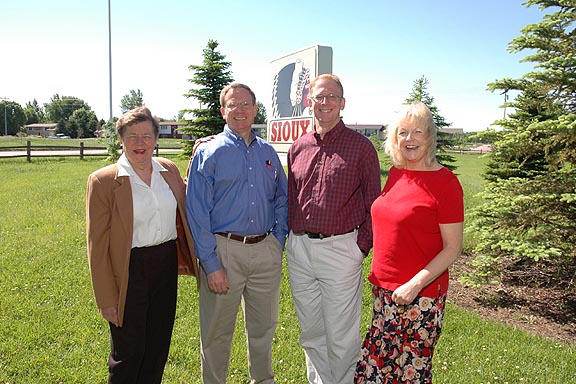
“Looking back at those first few years, I now realize that we could have been a poster child for how not to run a business,” he said. “I had a lot to learn, and the company needed to make a lot of changes to survive.” Jack took a class at USD — where he was older than any student and the instructor — in family business dynamics that introduced him to the Prairie Family Business Association.
The combined education and resources helped him start to turn things around.
“When I first came back, I heard about the association but thought how could they help us? They had members in real estate and drugstores and jewelry and didn’t have anyone who did what we did,” he said.
“But after I took the class in 1999, I went to my first PFBA annual conference and was on the edge of my seat the whole two days taking notes and eating it up. There’s really no other organization I found that could help with the family issues you have to deal with in a family business. As the saying goes: If you get the family business part wrong, there is nothing worse, and if you get it right, there is nothing better.”
Starting with the basics, he and his brother Pete put in place annual business plans, strategic plans, marketing plans, job descriptions, lean initiatives and other best practices, one after the next. It all started coming together, and these changes made a huge positive impact.
On the advice of family business experts, he added an outside board of directors in 2000, calling it “the most significant change we ever made. It raised the professionalism of board meetings and the entire company right off the bat, and the outside board provided much better direction, feedback and oversight from people who had already been successful at running a manufacturing company many times larger than our company. I would not have made it without the outside board and the PFBA.”
The first seven years after his return were tough. “The second seven years we started doing pretty well, and the third seven years were great. The last several years felt so much better, and it was way more fun for me and everyone else.”
Sales grew threefold, and profitability increased five or sixfold.
“We have always had very generous profit sharing and other benefits, but in the last few years, we had even more to share with the employees,” he said.
He built a team of people strong enough that he said it wasn’t too noticeable when he took two weeks off a year ago for the first time ever.
So when he thought of transitioning, his mind turned to his strong team.
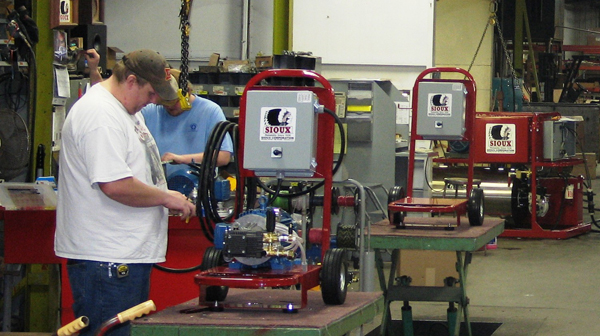
“If you’ve got a really strong management team and a great system in place, and you want to keep the company in the same community, selling the company to the management team is a great option,” he said. “We wanted to keep it in Beresford and do what’s best for the employees. You don’t get as much money when you sell using that option, but that wasn’t our goal. Keeping it in Beresford and considering the employees was.”
After several discussions last summer and fall, he and his brother Steve and sister Suzy and mother decided to sell the business to Meg Andersen, Eric Hansen and Brad Hyronimus.

“They have each worked at Sioux for at least 10 years. With the help of a great attorney at Lindquist & Vennum and an experienced M&A consultant from Eide Bailly, we asked if the three managers would be interested in one day owning the company, and they said absolutely,” Finger said. They worked out an arrangement to make that happen.
The transition keeps a family connection in the company, too. Andersen is Finger’s niece, who interned at the company while in business school and become controller after working six years in sales and sales management, and obtaining a master’s degree in accounting from USD.
“When I came back to Sioux, I started as general manager because my folks wanted to retire, which looking back was not ideal,” Finger said. “I wish I had returned sooner and spent about five years in engineering learning more about the equipment and five years in sales learning that part of the business, but that did not happen. With my niece, I said if you start at the bottom everybody will respect you more and you’ll learn a lot more.”
Hyronimus will be president and CEO. He was the first engineering intern at Sioux, and he graduated second in his mechanical engineering class at the South Dakota School of Mines & Technology. Hansen, who has degrees in mechanical engineering and a master’s degree in production management from SDSU, will manage production.
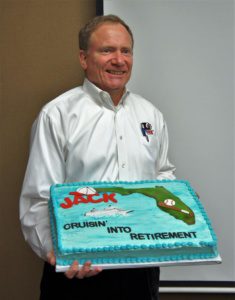
Finger retired from his role Dec. 31, 2017.
Even while growing his own business, Finger has shared knowledge with others. He’s a past board chairman of the Prairie Family Business Association, was on the dean’s advisory board of the SDSU engineering school for nine years and is currently chair of the advisory board of South Dakota Manufacturing & Technology Solutions. His company was selected as one of the 50 best places to work in South Dakota, North Dakota and western Minnesota in 2016 and 2017, and Sioux was selected as the Vicki Clarke Prairie Family Business of the Year for the Prairie Family Business Association in 2015.
“We are so fortunate to have the Finger family and Sioux Corp. as leaders in our organization,” Larscheid said. “We’re sure the company is well-positioned for many more years of success and are grateful to have helped play a role in it by connecting them with valuable tools and resources. They absolutely made the most out of our shared relationship.”

